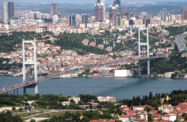The weakening of the lira could herald further problems for the cooling Turkish economy, with growth forecasts being scaled back and an expanding trade deficit taxing government efforts to keep interest rates low and inflation under control.
The currency has been coming under pressure from a number of quarters, having dropped some 13% since the beginning of the year against the dollar, with little sign of respite on the horizon. The lira fell to a record low of 2.07 to the dollar in late August, despite intervention from the Central Bank of the Republic of Turkey, which has raised the overnight lending rate to 7.75% and sold foreign exchange to prop up the currency.
One concern weighing down on the lira is the expectation that the US Federal Reserve will end its bond buying programme, pushing up US interest rates and attracting money out of emerging markets. Turkey is one of those most likely to be affected, as it relies heavily on external financing of its debts and supporting its extensive import habit with capital inflows.
Another factor affecting the lira is the threat of international military action against neighbouring Syria, in response to the alleged use of chemical weapons against civilian districts of Damascus by government forces in mid-August. Even a limited conflict, such as targeted strikes against Syria’s chemical weapons depots and command structure as proposed by Washington, could further undermine confidence in the region, with Turkey’s tourism sector – one of its main foreign currency earners – in line to suffer collateral damage. However, since the Syrian border is far way from the main tourist areas this peril is perhaps being exaggerated.
The lira’s decline could have a mixed impact on Turkey’s foreign trade, with a weaker currency having the potential to make products and services more appealing to overseas buyers. However, the overall effect on the balance of trade is expected to be negative, as it will put pressure on the import bill. Figures released by TurkStat on August 28 showed the trade deficit for July hit $9.81bn for the month, a 22% increase on the same month in 2012.
While Turkey’s exports rose 2.2% for the month, bringing in $13.11bn, imports shot up to $22.91bn, a 10% increase on the July figure for last year, putting export coverage over imports at just 57.2%. The poor July performance took the seven-month trade deficit to $60.46bn, a year-on-year increase of 18%. With the Turkish economy reliant on imported energy, any further depreciation of the lira would see the fuel bill rise, along with the cost of its other imports, a factor likely to feed into the already rising inflation rate, which hit 8.88% in July, its highest level for 10 months.
At a political level, the ruling Justice and Development Party (Adalet ve Kalkınma Partisi, AKP) government would like to see interest rates kept low, as the country is about to enter into a cycle of local, presidential and national elections through next year and into 2015. Relatively modest borrowing rates have helped support economic growth, one of the AKP’s policy cornerstones. Should the economy falter in the lead up to the polls, some of the government’s votes could shift to the opposition.
The government has sought to play down concerns over the economy and the health of the lira. Though acknowledging that there have been fluctuations in the value of the currency, Minister of Finance Mehmet Şimşek said such activity was common among emerging economies.
“Turkey is not an island, it’s an economy integrated into the world economy,” he said in late August. “Therefore Turkey can be affected positively or negatively by the developments in the world. This is more the consequence of a re-pricing of assets than a structural crisis.”
Nonetheless, the economy is losing momentum. Revised government estimates put GDP growth for this year at between 3% and 4%, down from earlier projections of up to 5%. Though still well above the rate of expansion of most countries in Europe and the region, the trend in recent months has been downward, with Economy Minister Zafer Çağlayan saying on August 11 that the increase in GDP for 2013 would be closer to 3%. While a recovery in Europe, Turkey’s largest export market, could help push this towards the upper end of the government’s expectations, gains could just as easily be lost through higher costs of fuel and other essential imports.
The central bank has said it does not intend to raise rates further this year, letting the lira find its own level in the market, although if this level falls too far for both the market and the government, the reserve may be pressured into further increases or another round of selling its foreign exchange reserves.

